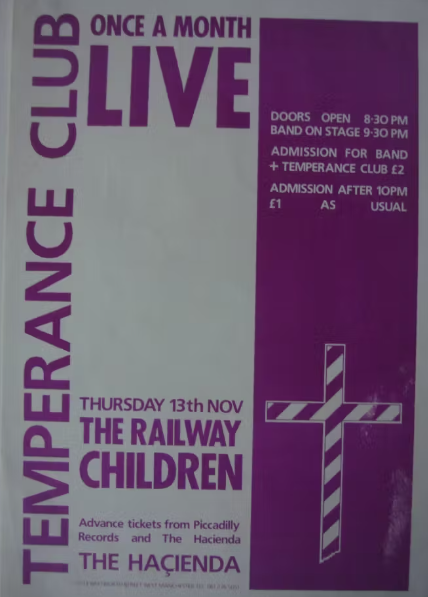/HISTORY/
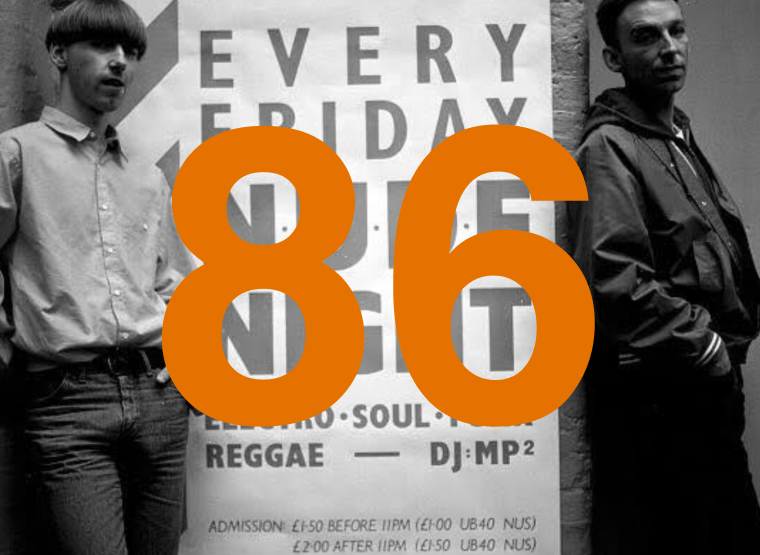
If 1985 had laid the groundwork for the Haçienda’s survival and rise from the difficulties of the early years, 1986 can be seen as the year that the future legacy of FAC 51 all started coming together. A lot of it down to the arrival of new general manager, Paul Mason in the January of 1986 along with Paul Cons handling press and promotions who became the guide for the clubs gay nights and influence which ultimately became “Flesh”.
Paul Mason had previously managed Rock City in Nottingham and began to make some initially unpopular but much needed changes at the club, moving the club towards regular DJ nights which were seen as more profitable and many long running nights including Dave Haslam’s Temperance Club began in 1986. Club culture in the UK was beginning to establish itself in 1986 and The Hacienda was right at the forefront of defining this as it took in early house records into its playlist whilst the Festival Of The Tenth Summer, a week of events in July was one of the first big moments to crystallise the emerging Madchester scene.
The regular nights at the club began to bed in well and the formula for later years began to be established with a growing emphasis on including fashion shows and installations. The start of the week saw Paul Cons’ Gay Monday bring the influence of Canal Street into the club, Martin Prendergast’s Tuesday club dispensed psychedelica and rock and Thursdays became Temperance Club from May onwards. Friday’s Nude night was increasingly setting the place for the emergent scene and although Saturdays had been through some changes following the departure of Hewan Clarke, Chad Jackson, DMC Champion of the year was resident up until the middle of the year before Wide with Dean Johnson took over the Saturdays.
Although the early part of the year saw Paul Mason bringing about his reforms, the switch to DJ led club nights proved a success, with the club actually turning a profit for the first time in 1986 while the I-D Party in June was the first time sweat was recorded coming off the ceiling and the walls in FAC 51. Although rare groove was in fashion at the time with the London style press, with Urban reissuing classics like Maceo And The Mack’s “Cross The Tracks” and The Jackson Sisters’ “I Believe In Miracles”, at The Haçienda this supplemented the existing policy of Motown, Rap and Soul but 1986 also saw the earliest American house records hit the clubs, eagerly picked up by Mike Pickering and championed at Nude.
Records release in 1986 which rocked The Hac include seminal tunes that became classics that are even revisited today, Doug Lazy’s “Let It Roll”, Mr Fingers “Can You Feel It”, Fingers Inc “Mystery Of Love”, Marshall Jefferson’s “Move Your Body”, Marshall’s Sleezy D “I’ve Lost Control”, Adonis’ “No Way Back”, Jamie Principle’s “Your Love” and Farley Jackmaster Funk’s cross-over smash “Love Can’t Turn Around”.
While Fridays became home to the sound of the new jacking grooves coming out of the States, Dave Haslam began his long running Temperance Club on Thursday 1st May 1986, which like Nude was to survive to the club’s temporary closure in 1990. Conceived by Dave and Paul Mason, the night finally accomplished Tony Wilson’s long cherished aim of bringing Manchester’s students to the venue , something Paul achieved by laying on a bus from Owens Park to the club. Mixing electro and hip hop such as Mantronix and Eric B alongside the indie staples of The Smiths, The Fall, New Order and classic rock tracks like The Stooges. Dave’s eclectic playlists and taste in music opened up a new avenue for the Hacienda and in many ways developed a new crowd for the Hacienda and not only students but also indie fans who’d previously been gig goers but not necessarily clubbers. The club was actually to see its first ever full sell out with a Temperance Club night on A Levels Results night in August, something that then became an annual event and this opening out of the regular crowd was to be an important factor in shaping The Hacienda towards the late Eighties and early Nineties.
The fourth birthday party came in May as well, and featured acrobats suspended from the ceiling as well as the party’s first fairground, something to be repeated in 1992 for the tenth birthday while a defining moment for both The Haçienda and the development of what came to be termed “Madchester” came with the “Festival Of The Tenth Summer” in July 1986. A week of events which commemorated both the infamous “I Swear I Was There” Sex Pistols concerts and the summer of punk a decade previously which had set bands like Joy Division and members of the Factory family including on their way. The week of events culminated with a huge G-Mex concert on the Saturday, headlined by The Fall, The Smiths and New Order and in many ways this occasion is looked back on as one of the real starting points leading to the crystallisation of the Manchester scene over the coming years to its highpoint which arguably came in 1990.
Although the club events were taking an increasing precedence over the live concerts, 1986 did see memorable gigs as well. The Velvet Underground’s Nico performed her last ever gig in January 1986 as Nico And The Faction, Vince Clarke’s post Yazoo project played twice during the year, along with bands such as Cabaret Voltaire, Spear Of Destiny, and New Order’s annual bail out show on Monday 13th October.
As the media and people outside Manchester and the Factory circle began to warm more to the club as well as the definite improvement in the running of the venue, 1986 had seen great improvements, the club was finally coming under control and there were very few security or drugs problems at the venue. With the Christmas and New Year’s Eve Parties a great success, it had been a breakthrough year for FAC51, and everyone involved, although not knowing yet what the future held, was very confident about the state of the club.
Some changes at the club. Paul Mason started as manager this year and Paul Cons is taken on as PR.
Mondays are Gay Monday with Cabaret artistes and Dj’s. Tuesdays are the Tuesday club with Martin Prendergast Playing Rock and Psychedelia. Fridays are Nude with Mike Pickering an Andrew Berry. Saturdays are Big Noise with Chad Jackson
Explore The Haçienda through the years
/TIMELINE/
JANUARY
Friday 17th – Nude Night
Saturday 18th – The Chad Jackson Groove
Monday 17th – Gay Monday with DJs The Fallen Angels
Tuesday 21st – The Happening
Thursday 30th – Nico and the Faction / Eric random. This was Nico’s last gig

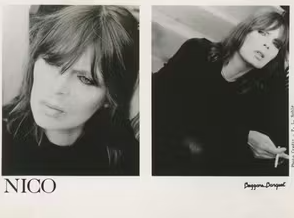
Nico modelled for Chanel, appeared in Federico Fellini’s La Dolce Vita, sang for The Velvet Underground and released a string of truly inimitable solo albums that influenced a vast range of artists from Elliott Smith to Throbbing Gristle. Yet despite such accolades landing her with true cult hero status, there’s some periods of Nico’s life that don’t fit as neatly and glamorously into her timeline: such as her seven years spent in Manchester between 1981-88.
Moving from Paris to New York, the German-born artist left the modelling and acting world and leapt into a musical one, famously falling into Andy Warhol’s circle and onto the The Velvet Underground’s seminal debut album. Between 1967 and 1974 she then released four solo albums. Her debut, ‘Chelsea Girl’ – penned by friends and collaborators like Lou Reed, John Cale, Bob Dylan and Jackson Browne – is a collection of wistful folk-pop, humming with breezy, infectious melodies and hushed vocals that feel like extensions of the softer side she brought to the Velvet Underground.
When encouraged to write her own material, Nico gained a new sense of individualism on albums such as ‘The Marble Index’ and ‘Desertshore’. Gone were the gently plucked acoustic guitars and sweet vocals and in was a droning harmonium, songs about death and decay and a voice that plunged new depths and forged new tones. This period birthed a newfound identity both sonically and aesthetically: gone too was the blonde hair and pristine white clothing and in was dyed hair, black clothing and scuffed motorcycle boots.
Nico became seemingly less concerned about appearing conventionally pretty, vocally. After over a decade of feeling defined by her appearance and beauty, she embraced a vocal style that seemed to both challenge and redefine what constituted a beautiful voice, as it often echoed out like a ship’s foghorn slowly rumbling amidst a thick smog. Not only did this strange yet innovative new music – along with her newfound anti-conventional aesthetic – come to define Nico’s most creative period, but the albums became the definitive avant-garde neoclassical works of the entire era. As John Cale – who produced the bulk of Nico’s solo work – says in the 1995 documentary Nico: Icon, “If you look at what she was writing at that time, there was nobody else doing anything else even remotely similar.”
What comes next is a lesser known, unexplored black hole of Nico’s life.
After 1981’s ‘Drama of Exile’, Nico found herself in the rather unexpected city of Manchester and remained there for the best part of a decade. Initially paired up with a local promoter (who replied: “who’s he?” when asked to put her on), Nico soon found herself managed by this man, Alan Wise.
James Young, who became a piano player in Nico’s band between 1981-86 and wrote a memoir about his time with her (Songs They Never Play on the Radio), recalls his first unexpected encounter with her, saying: “Out of nowhere there was this German lady on my doorstep with an old friend, Alan Wise. Before I knew it, Nico was taking over my flat. First she colonised the bathroom and once she’d ‘freshened up’ she took over the kitchen, as she wanted to make lentil soup. She carried a bag of dried lentils with her, like a nomad.”
Wise had looked up Young when on tour with Nico in Oxford. You might have guessed that the freshening up Young refers to was actually them seeking out a place for Nico to take heroin. By this stage she was deep into addiction with the drug. Later on that evening, Young got to see the other side of Nico, the one that wasn’t shooting up in his bathroom and making soup in his kitchen. “I was struck by the individuality of her music and persona, singing those strange medieval lullabies at her harmonium in an Oxford disco. It was totally incongruous and rather wonderful. I immediately grasped that this was a unique and original artist.”
Young soon found himself leaving his academic life in Oxford behind and moving to Manchester to join her band. Basing herself in Manchester during the 1980s may seem a bizarre choice for someone who has a history attached to the elegance of 1950s Paris or the bohemian boom of 1960s and ’70s New York but Young feels the city was something she could relate to. “Nico liked Manchester. It was a dark gothic city and was in a state of semi-dereliction at the time; empty Victorian warehouses, factories closing down. She said it reminded her of Berlin, the ruined city of her youth.” Graham Dowdall, who was also in Nico’s band, echoes that she gravitated towards the “post-industrial landscape and griminess,” but also adds that there was the allure of “cheap smack.”
Nico lived in various places in the city, from flats in Prestwich to squats in Hulme. Young recalls her having close to no possessions during this period. “Just her harmonium and a bag with stuff in: her notebook, drug works, incense and reading material.”
Stella Grundy saw Nico for the first time at 16 and had her life changed. At Manchester Library Theatre in a room thick with cigarette and marijuana smoke, she recalls a set that was “beautiful, powerful and dark.” Ignoring the heckles for Velvet Underground tracks such as ‘Heroin’, Nico played Grundy’s request of ‘Frozen Warnings’, which she’d nervously called out for. “I was enraptured. From that night on I decided I wanted to be an artist, writer, singer – anything to be part of this world.” Grundy would go on to be in bands such as Intastella and in 2007 wrote a multi-media play about Nico that ran for two years and is also now available as an eBook.
Grundy recalls seeing Nico drink in the local pubs of Prestwich, where apparently she would play pool with the locals who had no clue who she was. Occasionally she’d be pestered by people that did. “She didn’t like fans of the Velvet Underground mithering her about those times, although she was happy to write messages and autographs for people when asked. I’ve been shown a few of these items. Some people were unkind to her and took advantage though.” Grundy saw this up close as her boyfriend at the time even went backstage and stole her heroin needles as some sort of cultural memento from the “queen of the junkies”. Grundy even recalls being told that someone had stolen her diary.
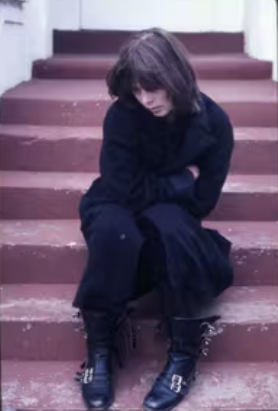
The day-to-day existence of Nico during her Manchester years resembled that of most heroin addicts: shooting up or trying to get gear to shoot up. She described herself as reclusive and lived in places with blood-splattered walls from syringe splats, which she shared with other local users and musicians including John Cooper Clarke. There were periods she would live off a diet purely of custard and would claim, with some pride, to go prolonged periods without bathing. Young feels that this period of perceived disintegration was not necessarily all sordid demise and the destruction of a talent but instead an extension of Nico’s redefined personality. She took pride in her greying hair, sagging skin and needle-marked arms because they were the antithesis to everything she had once been told she was wonderful for. “She seemed to be embracing the scars of time and addiction saying ‘this is who I am.”
As a result, in terms of writing and recording new music, the Manchester years were some of Nico’s least productive. But fast money was often required to pay for her heavy addiction, and a way to get that was by touring. Wise would organise shows in the UK, across Europe and even as far as Tokyo and America – something that could often prove problematic given the needs of Nico, as well as the needs of some of the other touring parties who had their own chemical needs and personality idiosyncrasies. Young remembers “a hopeless tour of the USA, playing clubs in the boiling heat of summer. No money. Nico withdrawing. Arguments and bickering, all in a car with the air conditioning switched off to save fuel.”
Both Young and Dowdall remember the repeating drawled line of “are we near the border yet?” coming from Nico when on tour and then a sort of pandemonium erupting: things being hidden and stashed, including in Nico’s underwear and in her anus. Young recalls even being given a handful of used syringes from her that he quickly had to throw out of the window into the nearby water before reaching border guards. “Her running out of smack at the wrong time – like before a gig – was always a big problem,” he recalls, “meaning one of us would have to go out and hustle for a connection on the street and inevitably get ripped off.”
On top of this, Nico and her manager had a volatile relationship on and off the road. Dowdall describes it as: “very complex and not entirely healthy, although both got a lot of positive things out of it.” Similarly, Young repeats this dysfunctional image. “Alan was a very intelligent guy,” he says. “He was also highly emotional. He developed a passion for Nico that was not reciprocated and this was a source of deep frustration for him. They had endless arguments. They lived by constantly tearing at each other like a crazed married couple. At the same time they were close friends. I would say that apart from Ari [Nico’s son] Alan was closest to Nico. I was never that close to her; my relationship was more professional. I realised early on that getting close to Nico meant sharing a propensity for addiction. Alan was a valium addict and his father had a chain of pharmacies. He understood the chemistry of need, he could facilitate. He responded to people who were ill, whether physically or psychologically. He went under the sobriquet of ‘Doctor’ and took damaged people into his care.”
Stella Grundy feels this dependency was a potentially damaging one at times. “As a child of the 1930s she did defer to men a lot,” she says, “allowing them to make decisions for her and not always the right ones. She would constantly be without enough money and of course heroin does not come for free. I actually think she just allowed people to control her like the drug. She was brave and talented and I believe lacked confidence and still felt she needed a man to help her when actually she didn’t. Her best work for me was her solo, playing the harmonium.”
Despite the savage addiction that controlled much of Nico’s existence, and the occasional shambolic and failing gigs in which her dark European music felt out of place with the shiny pop of the era, there were also moments of magic to be found. “She was actually really positive and encouraging to work with,” recalls Dowdall. “I remember playing with her and the mic was broken but Nico started to sing acoustically. Every hair on my body stood up. Her voice was huge and resonant with all the weight she carried. She also taught me instantly to deviate anything, she was a trooper – no mic, no problem.”
Nico and her band, the Faction, would make one last studio album, 1985’s ‘Camera Obscura’. The following year she made some significant changes in her life, as Young tells me: “In ’86 Alan persuaded Nico to go on the methadone programme, especially since her main reliable dealer had been busted and was in prison. I think this was a mistake. Methadone is a horrible drug, it zombifises people. I didn’t like what it was doing to her. I guess it made her easier to manage – no more running around to find a connection. Her health seemed to decline after that. We did a concert in Berlin at the Planetarium together and it was clear that she wasn’t well. She wanted to go to Ibiza to rest and review her life. I think she knew she was dying.” A short time later, in 1988, whilst in Ibiza, Nico did die, suffering a brain haemorrhage whilst out on a bicycle.”
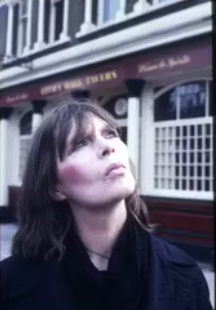
Setlist
Hand in Glove
Always Something There to Remind Me
I Don’t Owe You Anything
Long Live Love
Message Understood
Steven (You Don’t Eat Meat)
I’ll Stop at Nothing
Go Johnny Go!
Anyone Who Had a Heart
Frederick
A Girl Called Johnny
Girl Don’t Come
Are You Ready to Be Heartbroken
Encore: Jeane
Hand in Glove
“She said it reminded her of Berlin, the ruined city of her youth.”
Words by Daniel Dylan Wray – Original Article At Loud & Quiet here.
Thursday 23rd – Erasure
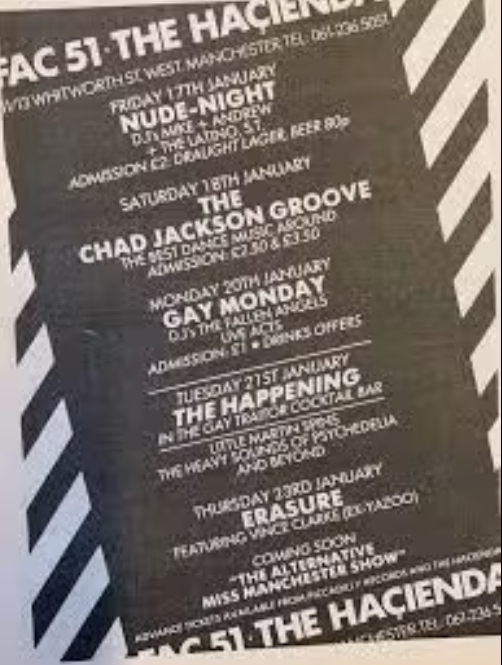
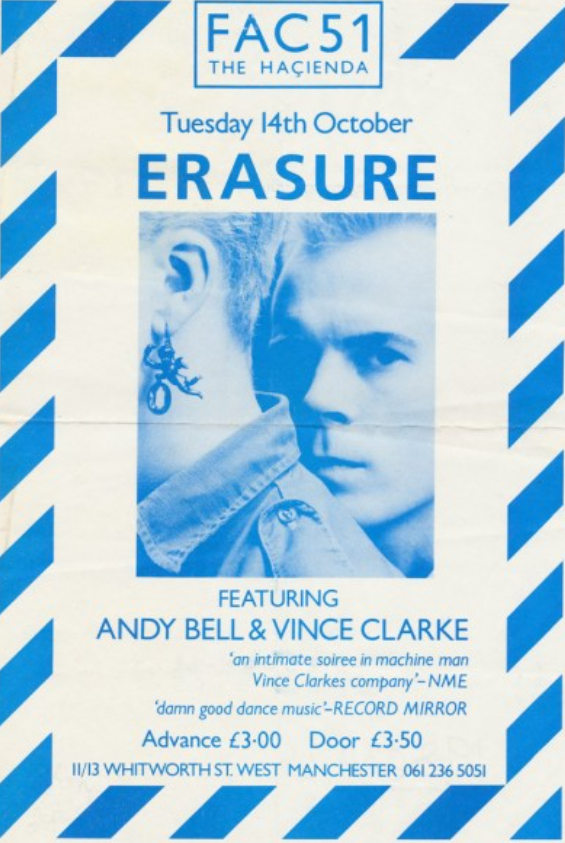
Setlist
Pistol
Senseless
Heavenly Action
Reunion
Sometimes
Who Needs Love Like That
Cry So Easy
My Heart… So Blue
March On Down the Line
Say What
Love Is a Loser
Sexuality
Oh l’amour
Gimme! Gimme! Gimme! (A Man After Midnight)(ABBA cover)
Push Me Shove Me
FEBRUARY
Monday 17th – Gone Hollywood an Art installation in the Gay Traitor by Jeremy Kerr
Tuesday 18th – Some Bizarre night with The Swans and Gifted
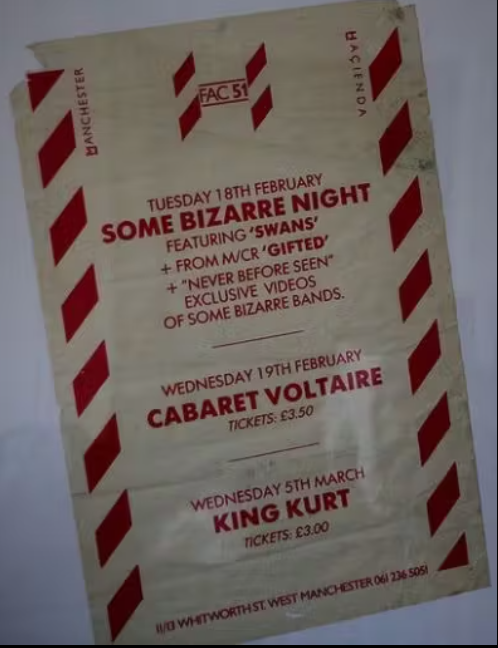
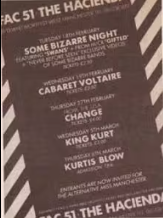
Wednesday 19th – Cabaret Voltaire
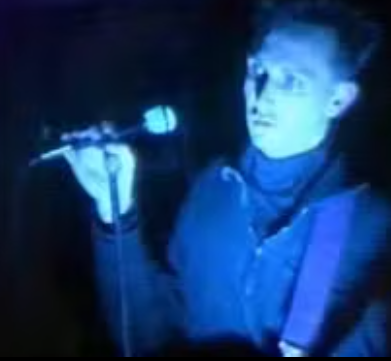
Setlist
PTrouble
Hells Home
Just Fascination
We Got Heart
Piledriver
Kino
Hey Hey
I Want You
Sex Money Freaks
Shakedown (The Whole Thing)
Thursday 27th – Change
MARCH
Thursday 5th – King Kurt. It was reported that the gig was so wild a woman in the audience broke her leg and didn’t notice

Tuesday 11th – Kurtis Blow
APRIL
Tuesday 5th – Big Audio Dynamite & Chiefs Of Relief

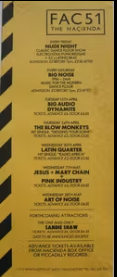
Big Audio Dynamite Setlists
Medicine Show
Stone Thames
BAD
Sony
Beyond the Pale
A Party
The Bottom Line
E=MC2
1999 (Prince cover)
Sudden Impact!
Chief Of Relief Setlists
Band details here.
Looking For A Beat
Where It All Began
Freedom to Rock
Dream Baby
The Chiefs Of Relief
Break Away
White City Boys
Walk About
Friday 11th – Fashion Pa’s commence
Thursday 24th – The Blow Monkeys
Saturday 26th – Disco, a name change for Chad Jacksons night
Wednesday 30th – Latin Quarter
MAY
The Temperance Club played what is now referred to as Indie. A dedicated student night with coaches at 2.00 back to the campuses. The night was probably the only one in the world where you could listen to funk, rap, rock and was the birthplace of the Indie-Dance crossover.
Thursday 1st – Temperance Club with DJ Hedd and Dave Haslam
Friday 2nd – Nude night with MP2. Martin Prendergast and Mike PIckering played Electro, Soul, Funk and Reggae. It was from here that the first House records where played.
Saturday 3rd – Music for the Modern Dancefloor with Andy Miller
Friday 9th – Nude with a Fashion show by Su King
Wednesday 7th – Jesus and Mary Chain, Fuzzbox & Pink Industry
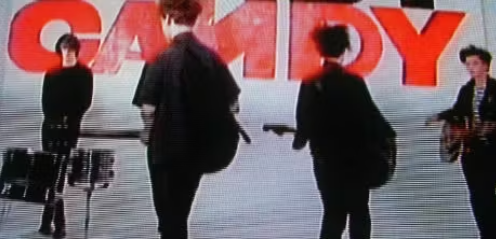
Jesus And Mary Chain Setlist
Taste of Cindy
The Living End
Just Like Honey
The Hardest Walk
Hit
Some Candy Talking
Mushroom
In a Hole
Never Understand
Cracked
Fuzzbox Setlist
Console Me
Spirit in the Sky (Norman Greenbaum cover)
Do I Want To?
Justine
Preconceptions
XX Sex
Love Is the Slug
Hollow Girl
You Got Me
Aaarrrggghhh!!!
Rules and Regulations
Fever (Eddie Cooley cover)
Tutti Frutti (Little Richard cover)
Pink Industry Setlist
This Is the Place
(Unknown)
(Unknown)
(Unknown)
What I Wouldn’t Give
Send Them Away
(Unknown)
Don’t Let Go
Monday 19th – Alternative Hair with an Alternative Miss Manchester contest
Wednesday 28th – Art of Noise
Wednesday 21st – 4th Birthday Party
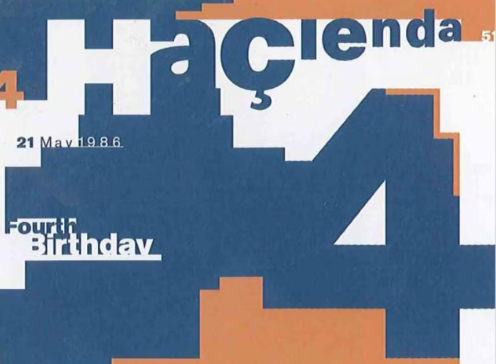
JUNE
Wednesday 4th – Crime And The City & Ghostdance
Wednesday 11th – Gene Loves Jezebel
Saturday 14th – iD Party
Monday 23rd – Sandy Shaw
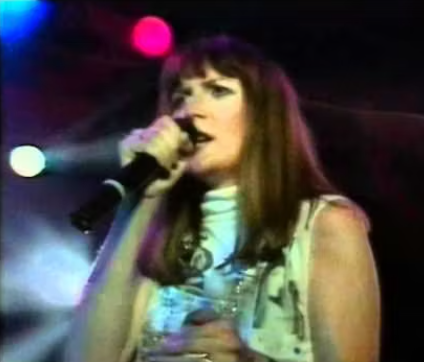
JULY
Tuesday 1st – Black Uhuru, The Wailers
Tuesday 8th – The Alarm
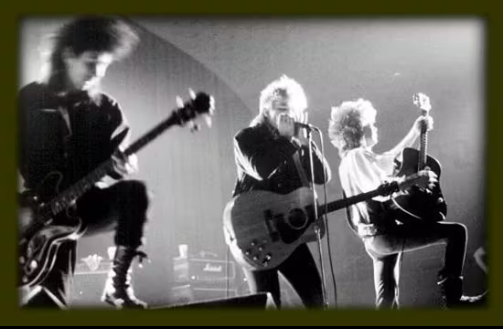
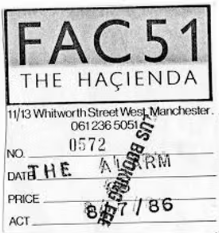
Setlist
Strength
Howling Wind
Knife Edge
Deeside
Dawn Chorus
One Step Closer to Home
Third Light
Absolute Reality
Blaze of Glory
Sixty Eight Guns
Unsafe Building
Marching On
The Stand (Prophecy)
Where Were You Hiding When the Storm Broke
Sunday 13th – Clothing The Naked Flesh With Plastic Flowers. A festival of the tenth summer fashion show.
Saturday 19th – Wide with Dean Johnson, Hedd and Dave Haslam
Wednesday 30th – Zodiac Mindwarp, MC Evil Bastard
AUGUST
Thursday 28th – Temperance Club, A level results night.
SEPTEMBER
Thurs 4th – Glenn’s Birthday Party

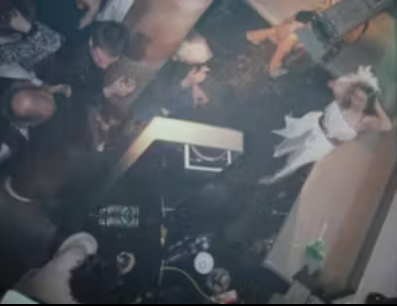
Weds 24th – Full Force, Lisa Lisa & Cult Jam, The Real Roxanne & Hit Man Howie
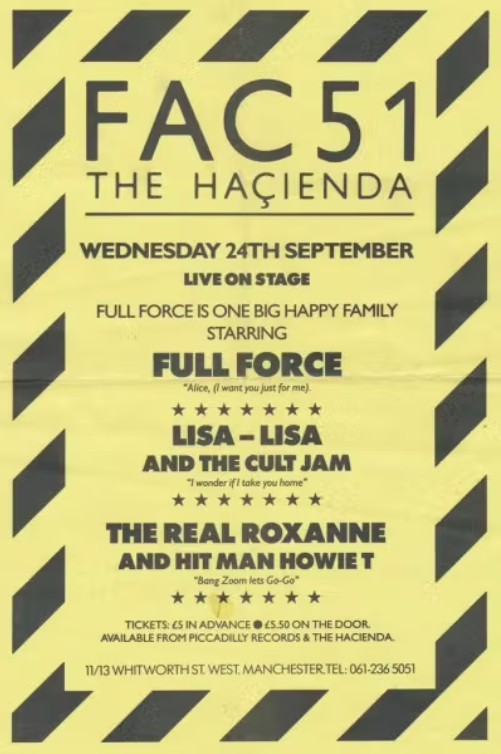
OCTOBER
Wednesday 1st – Trouble Funk
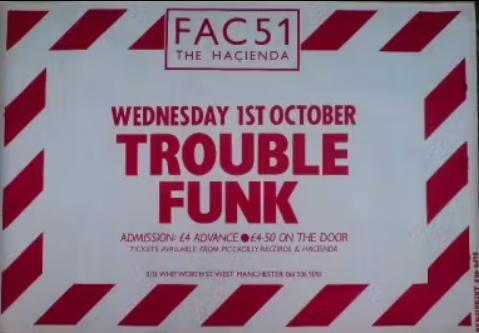
Monday 13th – New Order

Setlist
Sooner Than You Think
Bizarre Love Triangle
Subculture
All Day Long
Every Little Counts
Paradise
State of the Nation
Everything’s Gone Green
Weirdo
Sunrise
Temptation
Love Will Tear Us Apart
Tuesday 14th – Erasure
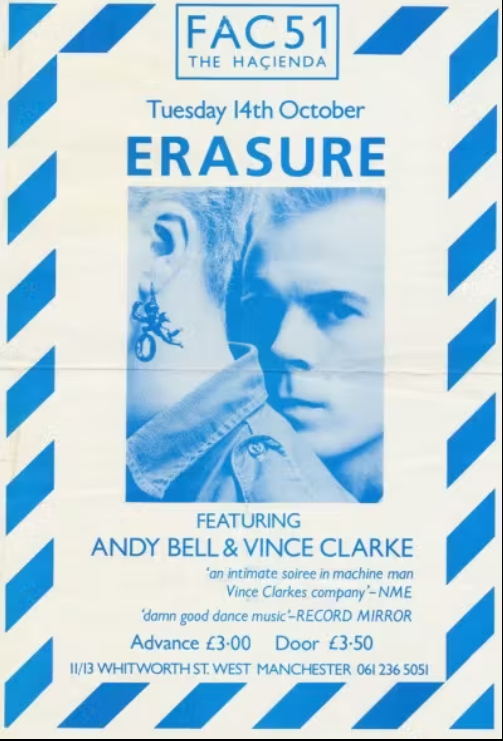

Setlist
Pistol
Senseless
Heavenly Action
Reunion
Sometimes
Who Needs Love Like That
Cry So Easy
My Heart… So Blue
March On Down the Line
Say What
Love Is a Loser
Sexuality
Oh l’amour
Gimme! Gimme! Gimme! (A Man After Midnight)
Push Me Shove Me
Tuesday 28th – Fabulous Thunderbirds
Wednesday 29th – The Residents, 13th anniversary show featuring Snakefinger
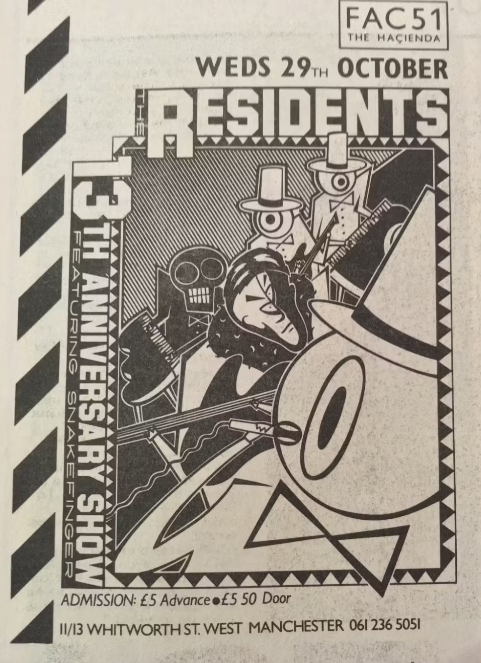
NOVEMBER
Thursday 13th – The Railway Children
